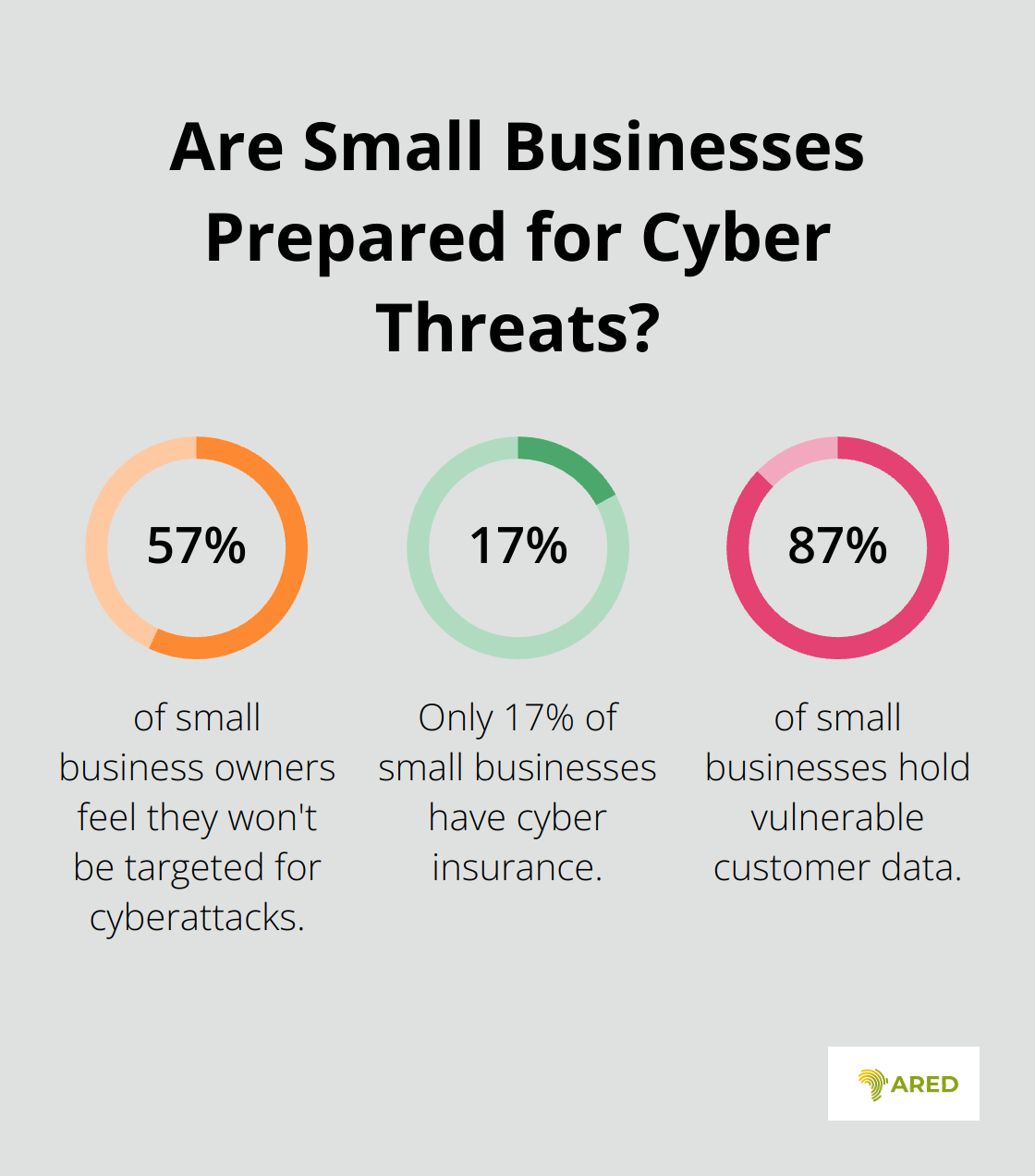
Cybersecurity for SMEs: Essential Guide
Cybersecurity for SMEs is no longer optional-it’s a necessity. Small and medium-sized businesses are increasingly targeted by cybercriminals, yet many lack the resources to protect themselves effectively.
At Shirikihub, we’ve seen firsthand how devastating cyber attacks can be for SMEs. This guide will equip you with essential strategies to safeguard your business against digital threats, helping you protect your assets, reputation, and bottom line.
The Hidden Costs of Cyber Attacks on SMEs
The Rising Threat to Small Businesses
Small and medium-sized enterprises (SMEs) have become prime targets for cybercriminals. The notion that SMEs are too small to attract attention is dangerously misleading. Some 57% of small business owners feel they won’t be targeted for cyberattacks, highlighting the urgent need for robust cybersecurity measures.
Common Cyber Threats Plaguing SMEs
Ransomware: A Growing Menace
Ransomware attacks lead the pack of cyber threats facing SMEs. These attacks encrypt a company’s data and demand payment for its release. In 2021, 82% of ransomware attacks were against companies with fewer than 1,000 employees.
Phishing: The Human Element
Phishing scams exploit the human factor in cybersecurity. Employees of small businesses encounter 350% more social engineering attacks than their counterparts in larger enterprises. These attacks often result in data breaches, with 87% of small businesses holding vulnerable customer data.
The Critical Importance of Cybersecurity for SMEs
SMEs cannot afford to ignore cybersecurity. A single successful attack can paralyze operations, tarnish reputations, and inflict significant financial losses. Despite these risks, 51% of small businesses operate without any cybersecurity measures, leaving them exposed to potential attacks.
Quantifying the Impact of Cyber Attacks
Financial Repercussions
The financial toll of cyberattacks on SMEs often exceeds initial estimates. While 95% of cybersecurity incidents at SMBs cost between $826 and $653,587, the true impact extends far beyond immediate monetary losses.
Reputational Damage
The harm to a company’s reputation can prove severe and long-lasting. A study found that 55% of U.S. consumers would likely discontinue business with companies that experienced data breaches. This erosion of customer trust can devastate an SME’s long-term financial health.
Recovery Time and Productivity Loss
The time required to recover from a cyberattack adds another layer of cost. Half of SMBs reported recovery times of 24 hours or longer following an attack. This downtime translates to lost productivity, missed opportunities, and additional expenses.
The Preparedness Gap
Despite the clear risks, many SMEs remain underprepared. Only 17% of small businesses have cyber insurance, and 64% lack familiarity with such protection. This absence of safeguards exposes many SMEs to potentially business-ending financial losses in the event of a successful attack.

As we move forward, it becomes clear that SMEs must take proactive steps to protect themselves from these evolving threats. The next section will explore essential cybersecurity measures that every SME should implement to fortify their digital defenses.
How SMEs Can Build a Strong Cybersecurity Foundation
Small and medium-sized enterprises (SMEs) often face challenges in implementing effective cybersecurity measures due to limited resources and expertise. However, a robust cybersecurity foundation is essential for protecting businesses from sophisticated cyber threats. This chapter outlines key strategies SMEs can adopt to strengthen their digital defenses.
Fortify Your Password Practices
Weak passwords represent a major vulnerability for SMEs. SMEs should implement a strong password policy that requires employees to use complex, unique passwords for each account. A password manager can help employees create and store secure passwords. A study by LastPass revealed that 91% of people know using the same password for multiple accounts is a security risk, yet 66% continue to do so. Strong password practices significantly reduce the risk of unauthorized access to systems.
Stay Current with Software Updates
Outdated software often serves as an entry point for cybercriminals. SMEs should establish a regular schedule for updating all software and operating systems across their organization. This includes computers, mobile devices, routers, and other network-connected equipment. Up-to-date systems close potential security gaps that attackers could exploit.
Educate Your Employees
Employees form the first line of defense against cyber threats. SMEs should implement a comprehensive cybersecurity awareness training program that covers topics such as identifying phishing emails, safe browsing habits, and proper handling of sensitive data. Regular training sessions and simulated phishing tests reinforce good security practices.
Implement Robust Backup and Recovery Procedures
Reliable backups can make the difference between a minor inconvenience and a major disaster in the event of a successful cyberattack. SMEs should implement a comprehensive backup strategy that includes regular, automated backups of all critical data. Storing backups in multiple locations (including off-site or cloud-based storage) ensures data can be recovered even if primary systems are compromised. Regular testing of backup and recovery procedures ensures they work as expected when needed.
Secure Your Network
Network protection is vital for safeguarding business data and operations. SMEs should implement a firewall to monitor and control incoming and outgoing network traffic. A Virtual Private Network (VPN) provides secure remote access to systems. Regular network vulnerability scans help identify and address issues promptly. Verizon’s report emphasizes the importance of network security for SMEs.

As cyber threats continue to evolve, SMEs must adapt their security measures accordingly. The next chapter will explore advanced cybersecurity strategies that can further enhance an SME’s digital resilience.
Advanced Cybersecurity Strategies for SMEs
Small and medium-sized enterprises (SMEs) must adopt sophisticated defense mechanisms to counter evolving cyber threats. This chapter explores cutting-edge approaches that SMEs can implement to enhance their security posture and stay ahead of cybercriminals.
Multi-Factor Authentication: A Critical Security Layer
Multi-factor authentication (MFA) adds an extra layer of security beyond passwords. MFA requires two or more verification factors, which significantly reduces the risk of unauthorized access. Microsoft reports that MFA blocks over 99.9% of account compromise attacks. SMEs should implement MFA across all critical systems and accounts as a top priority.
Endpoint Detection and Response: Proactive Threat Hunting
Endpoint Detection and Response (EDR) solutions provide real-time monitoring and response capabilities for endpoint devices. These tools use advanced analytics to detect and investigate suspicious activities, allowing SMEs to respond quickly to potential threats.
Security Audits and Penetration Testing
Regular security audits and penetration tests help SMEs identify vulnerabilities before attackers exploit them. These assessments provide valuable insights into an organization’s security posture and guide improvement efforts.
Incident Response Planning
An incident response plan outlines the steps an organization will take in the event of a cyber attack. This plan should detail roles, responsibilities, and procedures for containing and mitigating the impact of a security breach.
Cyber Insurance: Financial Protection
Cyber insurance provides financial protection against the costs associated with data breaches and cyber attacks. While not a substitute for robust security measures, it can help SMEs recover from the financial impact of a cyber incident.

SMEs should consider partnering with cybersecurity firms or managed service providers to leverage their expertise and resources when implementing these advanced strategies. A proactive, multi-layered approach to cybersecurity is essential for SMEs to protect their assets and reputation in today’s digital landscape.
Final Thoughts
Cybersecurity for SMEs is not a luxury but a necessity in today’s digital landscape. Small and medium-sized enterprises face numerous cyber threats that can have devastating consequences, from ransomware attacks to phishing scams. We’ve outlined essential measures that every SME should implement, including strong password policies, regular software updates, and comprehensive employee training programs.

The digital landscape constantly evolves, and so must our approach to cybersecurity. SMEs must stay informed about emerging threats and continuously update their security measures to stay ahead of cybercriminals. Advanced strategies like multi-factor authentication, endpoint detection and response solutions, and regular security audits can significantly enhance an SME’s defense against sophisticated cyber threats.
We at Shirikihub understand the unique challenges SMEs face in implementing effective cybersecurity measures. Our Smart WiFi management system (https://www.aredgroup.com) offers versatile connectivity options with built-in security features, helping SMEs enhance their digital infrastructure while maintaining robust protection against cyber threats. SMEs can significantly reduce their risk of falling victim to cyber attacks by implementing strong cybersecurity strategies and staying vigilant.


